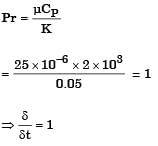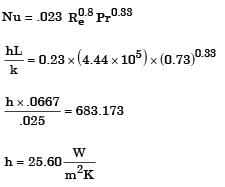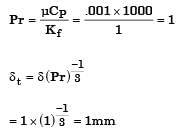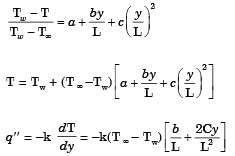Past Year Questions: Heat Transfer In Flow Over Plates And Pipes - Mechanical Engineering MCQ
15 Questions MCQ Test Additional Study Material for Mechanical Engineering - Past Year Questions: Heat Transfer In Flow Over Plates And Pipes
For the fluid flowing over a flat plate with Prandtl number greater than unity, the thermal boundary layer for laminar forced convection.
[1988]
A fluid flowing over a flat plate has the following properties: dynamic viscosity = 25 × 10–6 kg/ ms, specific heat = 2.0 kJ/kgK, thermal conductivity 0.05 W/mK. The hydrodynamic boundary layer thickness is measured to be 0.5 mm. The thickness of the thermal boundary layer would be
[1992]
| 1 Crore+ students have signed up on EduRev. Have you? Download the App |
Water (Prandtl number = 6) flows over a flat plate which is heated over the entire length. Which one of the following relationship between the hydrodynamic boundary layer thickness (δ) and thermal boundary layer thickness (δt) is true
[2001]
Consider a laminar boundary layer over a heated flat plate. The free stream velocity is U∝. At some distance x from the leading edge the velocity boundary layer thickness is δv and the thermal boundary layer thickness is δT. If the Prandtl number is greater than 1, then
[2003]
An un-insulated air conditioning duct of rectangular cross section 1 m × 0.5 m, carrying air at 20°C with a velocity of 10 m/s, is exposed to an ambient of 30°C. Neglect the effect of duct construction material. For air in the range of 20 – 30°C, data is as follows: thermal conductivity = 0.025 W/mK; viscosity = 18 μPa.s; Prandtl number = 0.73; density =1.2 kg/m3. For laminar flow Nusselt number is 3.4 for constant wall temperature conditions and , for turbulent flow, Nu = 0.023 Re0.8Pr0.33.The Reynolds number for the flow is
[2005]
An un-insulated air conditioning duct of rectangular cross section 1 m × 0.5 m, carrying air at 20°C with a velocity of 10 m/s, is exposed to an ambient of 30°C. Neglect the effect of duct construction material. For air in the range of 20 – 30°C, data is as follows: thermal conductivity = 0.025 W/mK; viscosity = 18 μPa.s; Prandtl number = 0.73; density =1.2 kg/m3. For laminar flow Nusselt number is 3.4 for constant wall temperature conditions and , for turbulent flow, Nu = 0.023 Re0.8Pr0.33.
The heat transfer per meter length of the duct, in watts, is
[2005]
The temperature distribution with in the thermal boundary layer over a heated isothermal flat plate is given by  where TW and T∝ are the temperatures of plate and free stream respectively, and y is the normal distance measured from the plate. The local Nusselt number based on the thermal boundary layer thickness δt is given by
where TW and T∝ are the temperatures of plate and free stream respectively, and y is the normal distance measured from the plate. The local Nusselt number based on the thermal boundary layer thickness δt is given by
[2007]
For flow of fluid over a heated plate , the following fluid properties are known: viscosity = 0.001 Pa.s; specific heat at constant pressure = 1 kJ/kgK; thermal conductivity = 1 W/mK.
The hydrodynamic boundary layer thickness at a specified location on the plate is 1 mm. The thermal boundary layer thickness at the same location is
[2008]
A pipe of 25 mm outer diameter carries steam. The heat transfer coefficient between the cylinder and surroundings is 5 W/m2K. It is proposed to reduce the heat loss from the pipe by adding insulation having a thermal conductivity of 0.05 W/mK. Which one of the following statements is TRUE?
[2011]
The ratios of the laminar hydrodynamic boundary layer thickness to thermal boundary layer thickness of flows of two fluids P and Q on a flat plate are 1/2 and 2 respectively. The Reynolds number based on the plate length for both the flows is 104. The Prandtl and Nusselt numbers for P are 1/8 and 35 respectively. The Prandlt and Nusselt numbers for Q are respectively
[2011]
Consider a two-dimensional laminar flow over a long cylinder as shown in the figure below.

The free stream velocity is U∝ and the freestream temperature T∝ is lower than the cylinder surface temperature T∝. The local heat transfer coefficient is minimum at point
[2014]
The non-dimensional fluid temperature profile near the surface of a convectively cooled flat plate is given by  where y is measured perpendicular to the plate, L is the plate length, and a, b and c are arbitrary constants. TW and T∝ are wall and ambient temperatures, respectively. If the thermal conductivity of the fluid is k and the wall heat flux is q', the Nusselt number Nu
where y is measured perpendicular to the plate, L is the plate length, and a, b and c are arbitrary constants. TW and T∝ are wall and ambient temperatures, respectively. If the thermal conductivity of the fluid is k and the wall heat flux is q', the Nusselt number Nu  is equal to
is equal to
[2014]
For flow of viscous fluid over a flat plate, if the fluid temperature is the same as the plate temperature, the thermal boundary layer is
[2015]
The Blausius equation related to boundary layer theory is a
[2015]
For flow through a pipe of radius R, the velocity and temperature distribution are as follows:  where C1 and C2 are constants. The bulk temperature is given by
where C1 and C2 are constants. The bulk temperature is given by  with Um being the mean velocity of flow. The value of Tm is
with Um being the mean velocity of flow. The value of Tm is
[2015]
|
1 videos|30 docs|57 tests
|
|
1 videos|30 docs|57 tests
|











 (Fluid thermal conductivity)
(Fluid thermal conductivity)
 = 10mm
= 10mm






















